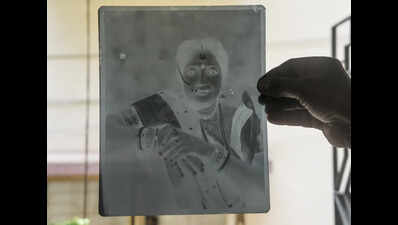ARTICLE AD BOX

MUMBAI: "Should I switch on the lights?" asks Neha Kamat. Seated in her softly tungsten-lit Goregaon home this rainy afternoon, she was sifting through butter-paper-shrouded negatives of the 1948 film 'Gajre' when the doorbell rang.Starring Motilal, 'Gajre' was the first of 800 Hindi films whose four lakh stills were shot by her grandfather, Damodar Kamat, who passed away at age 44 in 1967. "He died when my father was 13," she says, recalling her grandpa, a former signboard painter from Belgaum who founded Kamat Foto Flash in 1945, a Mumbai studio that went on to document the making of nearly every Hindi film for six decades.From a parched Guru Dutt to a tearful Meena Kumari, the studio’s stills—now endlessly shared on social media without credit—have become part of cinema’s visual memory. Today, Neha, its third-generation custodian, is digitising the fragile negatives to preserve this legacy.
"Besides celebrities, the archive is full of uncredited crew members—lightmen, makeup artists—whose work deserves to be remembered," she says, taking us through the boxes that are being opened to the public for the first time.An ongoing exhibition at NCPA’s Dilip Piramal Art Gallery showcases rare prints by the grandfather who preferred to stay behind the camera. Among them is a candid of Meena Kumari on the sets of 'Phool aur Patthar'.
"It was taken during a break. She was sitting with her chin resting on the chair. He noticed a spotlight being readied, saw the glow on her face, and asked her to hold still," says Neha. In another classic, Guru Dutt peers from what looks like a library shelf in 'Pyaasa', but the scene was in fact staged at the studio—on her grandfather’s manager’s desk, with office registers doubling as books.Born in 1923 to a priestly family in Belgaum, Kamat was a precocious lover of colour and languages, picking up English, Hindi, Marathi, Kannada, Konkani, and even Arabic.
At 17, he left home to pursue art in Kolhapur, apprenticing with photographer Kaka Samant and teaching himself the craft from German manuals—hence "Foto" instead of "Photo."He soon found work in Mumbai’s film industry while setting up a modest household with his wife. In their Dadar tenement, the couple would paste newspapers over tin walls to create a makeshift darkroom. "She helped him wash and develop prints," says Neha.
"Back then, photographers were indispensable. They were called in for everything from script narrations to on-set rehearsals."If heavy cameras couldn’t be carted to location, actors simply recreated scenes in the studio. "They would come in costume," says Neha, who is also a costume designer. By the mid-1940s, Kamat established his own studio in Mahalaxmi, soon photographing films spanning 'Pakeezah' to 'Umrao Jaan'.
"If not for him, people wouldn’t know what 'Don' director Chandra Barot even looked like," says Neha.While there were other still photographers, Damodar Kamat became known for close-ups and uncompromising quality. "He would reject ten bad stills to send out one good one. ‘Chalta hai’ was not in his vocabulary."His personal photographs reveal another side: his wife working a grinding stone on the floor, demurely handing him tea or sitting beside him and his mother in an affectionate embrace. "There are almost no photos of him with actors—except one with Raj Kapoor," Neha notes. "He was very shy. Rajji used to say: ‘Kab aaya, kab gaya, pata hi nahi chala.’"Kamat died suddenly of a heart attack on his birthday, November 27, 1967. Two trusted colleagues, Kamlakar Wagh and Shantaram Samant, kept the studio running until Neha’s father, Vidyadhar, took charge. Trained in Kathak, Neha grew up as a quiet observer on sets while her father worked. "Once, during the shoot of 'Junoon', I saw him get so close to a tiger that its jaw clamped down on the lens and blacked it out."Though she did not become a photographer, Neha helped her father prepare glass slides for theatres and eventually took over the daunting task of archiving.
Today, while she also works as a line producer, much of her time goes into preserving the family’s vast collection. A large portion was digitised. Paradoxically, "the digital copies take up more space than the negatives," she smiles, recalling the dozens of CDs, pen drives, and hard drives already consumed.The digital age may have democratised still photography—if not rendered it obsolete—but Neha believes her grandfather would not have turned cynical. "If he were alive, he would have embraced technology," she says. "He always found a way to stand out."



.png)
.png)
.png)
















 1 hour ago
4
1 hour ago
4









 English (US) ·
English (US) ·